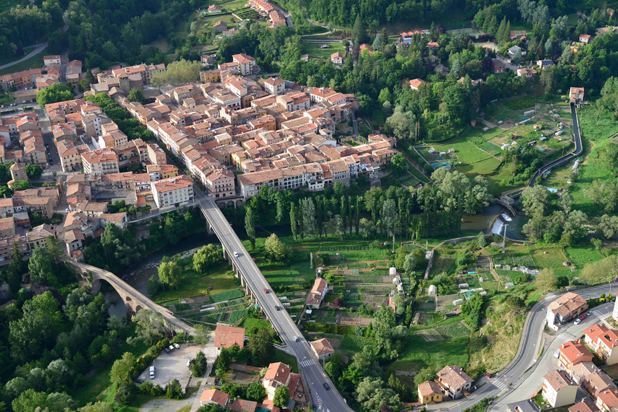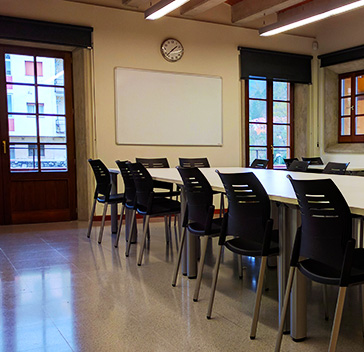Published The municipality of Sant Joan de les Abadesses (53.6 km2) limits to the N by a small strip with Camprodon, to the NE with Sant Pau de Segúries, to the E with the Vall de Bianya (Garrotxa) and to the SE with Riudaura (Garrotxa). In the S it confronts Vallfogona de Ripollès and from there to the SW with Ripoll. The whole part between the SW and the N is bordered by Ogassa. Sant Joan de les Abadesses focuses on the sector of the Ter valley limited to NE by the confluence of the Quatrecases stream with the Ter and SE by the confluence of the Ribamala stream also with the Ter.

It forms a typical valley of the Pre-Pyrenees heading NE-SW, extended between the southern slopes of the Taga and the Serra Cavallera, in the N, and the northern slopes of the Puig Estela mountain range and the Castelltallat hill, in the SE. The term Sant Joan has an appendix, to the east of the hill of Castelltallat, which goes into the region of La Garrotxa at the head of the Vall de Bianya, where the neighborhood of Santa Llúcia de Puigmal is located.
It is a raspberry valley, covered with pastures (which gradually occupy the corominas of the farmhouses that are depopulated on the slopes of the valley) and pine, oak, or beech forests in the highest places.
The head of the municipality is the town of Sant Joan de les Abadesses. The municipality also includes two factory colonies: the Colònia Llaudet and the Colònia Jordanian. The rest of the term is disseminated.
Life is concentrated at the bottom of the valley and in the town of Sant Joan, along the Ter and the road (C-26) from Ripoll to Camprodon and the Coll d’Ares (which allows you to reach Vallespir). Another important road is Sant Joan to Olot by Santigosa, which links the Caubet pass with the road that comes from Ripoll and that connects Ripollès with La Garrotxa and with the lands of Girona.
Another access route was the railway from Barcelona to Sant Joan de les Abadesses, built between 1875-80 by the Society of the Railway and Mines of Sant Joan de les Abadesses, a company that exploited the coal mines of Surroca and Ogassa, one of the first engines of development of the valley. Currently, the train no longer passes through Sant Joan, but arrives in Ripoll, to then continue towards France. The Sant Joan-Ripoll section fell into disuse until its final closure in 1980.
La població
The population (santjoanins/es) suffered greatly from the depopulation of the 14th century, once the initial population thrust had passed in the 13th century. Thus, in 1370, the village had only 58 families, almost half of which it had reached by the end of the previous century. At the end of the 14th century, it began a remarkable straightening, and in 1397 it already had 80 families, 32 of which were dedicated to prairies and 15 to the art of knitting; the rest were people of trade, such as leather, tailors, shoemakers and bracers. A series of privileges granted by the abbots, who were barons of the town, confirmed by the kings, maintained a fairly stable census in the town of San Juan, which ranged between 100 and 150 families throughout the 16th and 18th centuries. The entire term had 240 families in 1626 and 287 in 1782.
In the middle of the 19th century, the municipality reached 2,200 inhabitants, most of whom were dedicated to the work of the countryside and livestock and the rest to the old wool industry of the prairies. The industrialization of the area at the end of the 19th century and, above all, at the beginning of the 20th century, changed living conditions and the town passed from 2 995 h in 1900 to 3 993 h in 1936. The civil war of 1936-39, and then the 1940 flood, marked a sharp population decline, from which it did not recover until after 1950. Since then, industrial redress increased the population, although at a not very accelerated rate, since it passed from 3 905 hours in 1950 to 4,247 hours in 1981.
In the last two decades of the 20th century, however, the population decreased (3,896 h in 1991 and 3,566 h in 2001). With the turn of the century, however, there was a slight demographic increase and in 2005 3,621 hours were counted.
Currently, the census figures the number of inhabitants at 3.295.
L'economia
Sant Joan de les Abadesses is a predominantly industrial municipality, although it also maintains a small agricultural and livestock activity. Integrated into the Baix Ripollès, it has remained on the margins of the Ribes and Camprodon Valleys, with a longer tourist trajectory that originated at the end of the 19th century. However, in recent years, slowly but constantly, our people have promoted the services sector and, above all, tourist activity, becoming a destination for Catalans and foreigners who visit their unique cultural, architectural, landscape, and social heritage. This slow way of evolving has meant that tourism has been integrated with a fair proportion and offering an authenticity that our visitors appreciate.
A good example of this paradigm shift is the rural tourism houses that have been created in the last 15 years. At the level of administration, an effort has also been made to position the Baix Ripollès and enhance its tourism. The clearest example is the project 'Terra de Comtes I Abats', which began in 2005 and has gradually taken shape and body.

